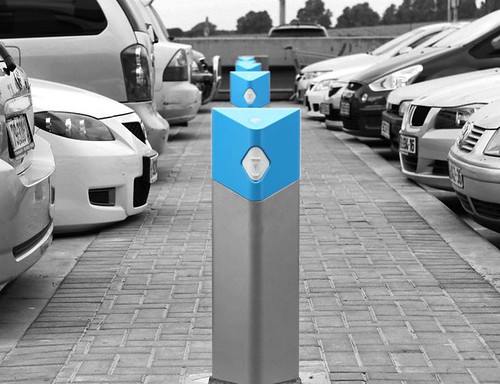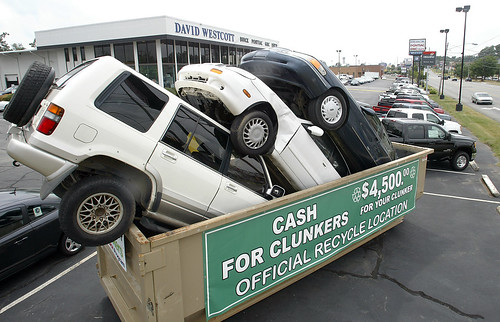Cash for Clunkers Update: Program Ends On A Positive Note & With A Negative Foot Note; Dealers Get Another 24 hrs to File Reimbursement Paperwork; List of Top 10 Contenders & Losers
Contributing Sources: CNN Money; Jalopnik ; LA Times & Autoblog Green)
This post is sponsored by LemonFree.com
Finito! Finished! Over! Gone! Done! End of the Road! Swan Song! Whatever the buzz word you would like to use for marking the end of the “successful” Cash for Clunkers Program, please feel free to do so. Many buyers made it out of the dealers with a sigh of relief while many dealers are still left wringing their hands over the delays in the Government’s administrative machine that processes the vouchers.
Amdist all this madness and hype surrounding the C4C, for many of us in the transportation business might take a couple of days (or even weeks) to understand the full impact of the program’s final days. Hopefully it is all good. In the meanwhile, TransportGooru went looking for the statistics on how the programs as well as the vehicles tallied up so far and found it for you from the reliable sources in our Automotive web reporting sphere (including Autoblog, Jalopnik, etc).
The ever popular Website, Jalopnik reports that as of Friday morning the number of transactions submitted numbered 489,269 with a dollar value of $2.04 billion. This morning the number reached 635,186 transactions with a dollar value of $2.65 million. So far (as of 7:47 AM August 24, 2009) the number of vehicles purchased have overwhelmingly been passenger cars (283,104) and category 1 trucks (166,686), with just a few category 2 (31,862) and category 3 (1,300) trucks. On the other end, the majority of vehicles turned in are category 1 trucks (318,249) and category 2 trucks (81,599) with just 78,265 passenger cars. Was there a surge of sales over the weekend? How successful has the program been? Once the deadline has passed, it’ll be interesting to see where the final MPG improvements and rankings of purchased and clunked cars end up. Shouldn’t have to wait long.
It would be hard to have a popular program without any drama, right? The New York Times reports that auto dealers swimming in applications for the “Cash for Clunkers” program now have a little extra time to fill out those forms. The Web site that dealers use to submit rebate applications crashed this afternoon, the Department of Transportation said. As a result, dealers can file for rebates until noon on Tuesday, though the deadline for sales is still 8 p.m. Monday. Car shoppers flooded sales lots this weekend after the announcement Thursday that the program was ending.
The Transportation Department said that despite a large increase in the system’s capacity, the website was down temporarily Monday. By then, dealers had submitted 625,000 applications worth more than $2.5 billion.
The department’s website, which has had problems throughout the program’s short life, was down for at least six hours Monday amid a last-minute rush to submit rebate applications, said Bailey Wood, a spokesman for the National Automobile Dealers Assn.
Glitches aside, Transportation Secretary Ray LaHood spent Monday taking a victory lap. “This program has been a lifeline to dealers,” Mr. LaHood said in Norristown, Pa. “It’s been a lifeline to the scrapyards who are getting these cars and can sell water pumps, and batteries and other parts. It’s also been a lifeline to the credit unions and banks processing all these loans. It’s been a win-win-win all around.”
AutoNation (AN, Fortune 500), the country’s largest dealership chain, stopped doing Cash for Clunker transactions after Friday. AutoNation had completed over 12,000 deals, according to spokesman Mark Cannon.
“It’s been a great run,” Cannon said.
Under Clunkers, which launched July 27, vehicles purchased after July 1 are eligible for refund vouchers worth $3,500 to $4,500 on traded-in cars with a fuel economy rating of 18 miles per gallon or less.
here is an updated list of traded-in and purchased cars (curtesy of our friends at Jalopnik).
Top 10 New Vehicles Purchased
1. Toyota Corolla
2. Honda Civic
3. Ford Focus FWD
4. Toyota Camry
5. Hyundai Elantra
6. Toyota Prius
7. Nissan Versa
8. Ford Escape FWD
9. Honda Fit
10. Honda CR-V 4WD
Top 10 Trade-In Vehicles
1. Ford Explorer 4WD
2. Ford F150 Pickup 2WD
3. Jeep Grand Cherokee 4WD
4. Jeep Cherokee 4WD
5. Ford Explorer 2WD
6. Dodge Caravan/Grand Caravan 2WD
7. Chevrolet Blazer 4WD
8. Ford F150 Pickup 4WD
9. Chevrolet C1500 Pickup 2WD
10. Ford Windstar FWD Van
This list is subject to change as the final numbers come in. So stay tuned for further updates.














